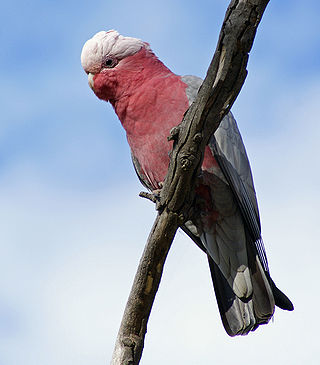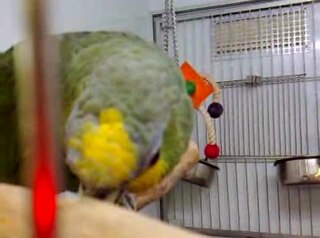
Macaws are a group of New World parrots that are long-tailed and often colorful. They are popular in aviculture or as companion parrots, although there are conservation concerns about several species in the wild.

The family Psittacidae or holotropical parrots is one of three families of true parrots. It comprises the 12 species of subfamily Psittacinae and 167 of subfamily Arinae including several species that have gone extinct in recent centuries. Some of the most iconic birds in the world are represented here, such as the blue-and-yellow macaw among the New World parrots and the grey parrot among the Old World parrots.

Amazon parrots are parrots in the genus Amazona. They are medium-sized, short-tailed parrots native to the Americas, with their range extending from South America to Mexico and the Caribbean. Amazona is one of the 92 genera of parrots that make up the order Psittaciformes and is in the family Psittacidae, one of three families of true parrots. It contains about thirty species. Most amazons are predominantly green, with accenting colors that depend on the species, and they can be quite vivid. They feed primarily on seeds, nuts, and fruits, supplemented by leafy matter.

The true parrots are about 350 species of hook-billed, mostly herbivorous birds forming the two superfamilies Psittacidae, and Psittaculidae, two of the three superfamilies in the biological order Psittaciformes (parrots). True parrots are widespread, with species in Mexico, Central and South America, sub-Saharan Africa, India, Southeast Asia, Australia, and eastwards across the Pacific Ocean as far as Polynesia. The true parrots include many of the familiar parrots including macaws, conures, lorikeets, eclectus, Amazon parrots, grey parrot, and budgerigar. Most true parrots are colourful and flighted, with a few notable exceptions.

A cockatoo is any of the 21 species of parrots belonging to the family Cacatuidae, the only family in the superfamily Cacatuoidea. Along with the Psittacoidea and the Strigopoidea, they make up the order Psittaciformes. The family has a mainly Australasian distribution, ranging from the Philippines and the eastern Indonesian islands of Wallacea to New Guinea, the Solomon Islands and Australia.

Home Alone 3 is a 1997 American family comedy film directed by Raja Gosnell in his directorial debut, written and co-produced by John Hughes, and starring Alex D. Linz and Haviland Morris. A standalone sequel to Home Alone 2: Lost in New York (1992), it follows Alex Pruitt, an 8-year-old boy who defends his home from a dangerous band of international criminals working for a terrorist organization. It is the third film in the Home Alone franchise, and the first not to feature actor Macaulay Culkin, director Chris Columbus, or composer John Williams; Gosnell had previously served as editor on the first two Home Alone films. It is also the final film in the Home Alone franchise to receive a theatrical release.

A companion parrot is a parrot kept as a pet that interacts abundantly with its human counterpart. Generally, most species of parrot can make excellent companions, but must be carefully managed around other common pet species like dogs and cats as they might be hostile towards them.

The Moluccan eclectus is a parrot native to the Maluku Islands (Moluccas). It is unusual in the parrot family for its extreme sexual dimorphism of the colours of the plumage; the male having a mostly bright emerald green plumage and the female a mostly bright red and purple/blue plumage. Joseph Forshaw, in his book Parrots of the World, noted that the first European ornithologists to see eclectus parrots thought they were of two distinct species. Large populations of this parrot remain, and they are sometimes considered pests for eating fruit off trees. Some populations restricted to relatively small islands are comparably rare. Their bright feathers are also used by native tribespeople in New Guinea as decorations.
The Pirate Parrot is a costumed mascot of the Pittsburgh Pirates of Major League Baseball. He was introduced in 1979 in response to the popularity of the Phillie Phanatic introduced one year earlier, as the Pirates and Philadelphia Phillies had a fierce intrastate rivalry at the time.

The neotropical parrots or New World parrots comprise about 150 species in 32 genera found throughout South and Central America, Mexico, the Caribbean islands and (formerly) the southern United States. Among them are some of the most familiar and iconic parrots, including the blue and gold macaw, sun conure, and yellow-headed amazon.

Talking birds are birds that can mimic the speech of humans. There is debate within the scientific community over whether some talking parrots also have some cognitive understanding of the language. Birds have varying degrees of talking ability: some, like the corvids, are able to mimic only a few words and phrases, while some budgerigars have been observed to have a vocabulary of almost 2,000 words. The hill myna, a common pet, is well known for its talking ability and its relative, the European starling, is also adept at mimicry. Wild cockatoos in Australia have been reported to have learned human speech by cultural transmission from ex-captive birds that have integrated into the flock.

Geoffroyus is a genus of parrot in the family Psittaculidae. The four species are found in and around New Guinea, the Solomon Islands, northern Australia and the islands of Indonesia. It contains the following species:

Madarasz's tiger parrot is a species of parrot in the family Psittaculidae native to New Guinea. Its natural habitat is subtropical or tropical moist montane forests.

Tiger parrots are members of the genus Psittacella in the family Psittaculidae, named for their tiger-striped backs. Established by Hermann Schlegel in 1871, the genus contains the following species, all of which are endemic to the island of New Guinea.

The New Zealand parrot family, Strigopidae, consists of at least three genera of parrots – Nestor, Strigops, the fossil Nelepsittacus, and probably the fossil Heracles. The genus Nestor consists of the kea, kākā, Norfolk kākā and Chatham kākā, while the genus Strigops contains the iconic kākāpō. All extant species are endemic to New Zealand. The species of the genus Nelepsittacus were endemics of the main islands, while the two extinct species of the genus Nestor were found at the nearby oceanic islands such as Chatham Island of New Zealand, and Norfolk Island and adjacent Phillip Island.

Parrots (Psittaciformes), also known as psittacines, are birds with a strong curved beak, upright stance, and clawed feet. They are conformed by four families that contain roughly 410 species in 101 genera, found mostly in tropical and subtropical regions. The four families are the Psittaculidae, Psittacidae, Cacatuoidea (cockatoos), and Strigopidae. One-third of all parrot species are threatened by extinction, with a higher aggregate extinction risk than any other comparable bird group. Parrots have a generally pantropical distribution with several species inhabiting temperate regions as well. The greatest diversity of parrots is in South America and Australasia.

Psittacopasseres is a taxon of birds consisting of the Passeriformes and Psittaciformes (parrots). Per Ericson and colleagues, in analysing genomic DNA, revealed a lineage comprising passerines, psittacines and Falconiformes. The group was proposed following an alignment of nuclear intron sequences by Shannon Hackett et al. in 2008. It was formally named as Psittacopasserae in a 2011 Nature Communications article by Alexander Suh and other authors working with Jürgen Schmitz's group, based on genetic analysis of the insertion of retroposons into the genomes of key avian lineages over the course of evolution during the Mesozoic Era.

The grey parrot, also known as the Congo grey parrot, Congo African grey parrot or African grey parrot, is an Old World parrot in the family Psittacidae. The Timneh parrot (Psittacus timneh) once was identified as a subspecies of the grey parrot, but has since been elevated to a full species.


















